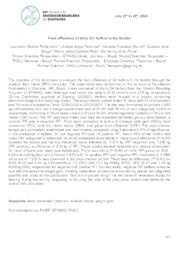Feed efficiency of dairy Gir heifers in the feedlot.
Feed efficiency of dairy Gir heifers in the feedlot.
Author(s): FERNANDES, L. O.; PASCHOAL, J. J.; MACIEL, G. A.; BRAGA, G. J.; REIS, N. J. C.; PAIVA, M. I. de
Summary: The objective of the study was to evaluate the feed efficiency of Gir heifers in the feedlot through the residual feed intake (RFI) evaluation. The experiment was carried out on the campus of Faculdades Associadas in Uberaba, MG, Brazil. It was evaluated 43 dairy Gir heifers from the Genetic Breeding Program of EPAMIG, with initial age and mean live weight of 20 months and 279 kg, respectively (Ethics Committee approval of Epamig: 02/2020). Heifers were housed in a feedlot containing electronic troughs and weighing scales. The experimental period lasted 91 days with 21 of adaptation and 70 days of evaluation, from 12/26/2020 to 03/27/2021. The diet was formulated to provide 0.450 kg LW/head/day and had a forage:concentrate ratio of 74:26, with 76.4% of corn silage and 23.6% of concentrate, containing 8.3% of crude protein (CP) and 64.8% of total digestible nutrients (TDN) on dry matter (DM) basis. The RFI was determined and then two experimental heifer groups were formed, a positive RFI and a negative RFI. They were compared in terms of average daily gain (ADG), feed conversion (FC), daily dry matter intake (DMI), and gross feed efficiency (GFE). The experimental design was completely randomized and means were compared using Tukey test at 5% of significance. In the evaluation of heifers, 24 had negative RFI and 19 positive RFI. About 56% of the heifers had lower DMI compared to estimated, of which considered more efficient. There was a difference (P<0.05) between the lowest and highest individual intake followed by -1.215 kg (RFI negative) and 1.936 kg (RFI positive), a difference of 3.15 kg of RFI. These results showed variability and chance of selection for more efficient and lower cost individuals. There was effect (P<0.05) of heifer RFI group on DMI - 6.29 and 5.43 kg/day, and 2.14 and 1.81% LW, for positive RFI and negative RFI, respectively. A DMI reduction of 13.67% was observed in the experimental period. There was no difference (P>0.05) for ADG (0.45 and 0.44 kg LW/head/day), FC (15.4 and 13.2 kg DM/kg ADG), GFE (0.07 and 0.08 kg ADG/kg DMI), respectively for negative and positive RFI. Consequently, negative RFI heifers consume less with the same live weight gain, allowing better-feed conversion in the rearing phase, reducing feed quantity and costs of milk production. This fact is proven trough the reduction of necessary inputs for feeding during the rearing, impacting in reducing the cost of the production system and indirectly the cost of milk production.
Publication year: 2022
Types of publication: Abstract in annals or event proceedings
Unit: Embrapa Cerrados
Keywords: Ganho de Peso
Observation
Some of Embrapa's publications are published as ePub files. To read them, use or download one of the following free software options to your computer or mobile device. Android: Google Play Books; IOS: iBooks; Windows and Linux: Calibre.
Access other publications
Access the Agricultural Research Database (BDPA) to consult Embrapa's full library collection and records.
Visit Embrapa Bookstore to purchase books and other publications sold by Embrapa.

